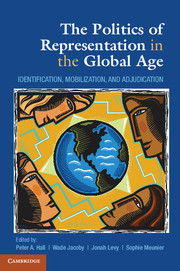Book contents
- Frontmatter
- Dedication
- Contents
- Abbreviations
- Acknowledgments
- Foreword
- 1 Introduction
- Part I The Politics of Interest Representation
- Part II Responding to the Challenges of a Global Era
- Part III New Institutional Settings for Representation
- 7 Blurring Political and Functional Representation
- 8 Altering Politics
- 9 Private Regulation (and Its Limitations) in the Global Economy
- Short Biographies of Editors and Contributors
- Index
- References
7 - Blurring Political and Functional Representation
Subnational Territorial Interests in European Multilevel Governance
Published online by Cambridge University Press: 05 June 2014
- Frontmatter
- Dedication
- Contents
- Abbreviations
- Acknowledgments
- Foreword
- 1 Introduction
- Part I The Politics of Interest Representation
- Part II Responding to the Challenges of a Global Era
- Part III New Institutional Settings for Representation
- 7 Blurring Political and Functional Representation
- 8 Altering Politics
- 9 Private Regulation (and Its Limitations) in the Global Economy
- Short Biographies of Editors and Contributors
- Index
- References
Summary
It was a remarkable neo-liberal accomplishment to create a 500 million person market without internal borders and other impediments to the free circulation of goods, capitals, services, and persons where twenty-eight different national markets separated by tariff and nontariff barriers, different regulatory regimes, and different currencies once existed. Whether it is to be understood as an embodiment of global forces or, rather, as an attempt to stop them at Europe's gates, the creation of the Single European Market (SEM) is certainly inspired by neo-liberal principles (Hooghe and Marks 1997). Tremendous pressure is exerted on these countries’ economies and societies by intensified economic competition and common social trends, such as the lengthening of life expectancy, the aging of the native population, and the massive inflow of immigrants. We would rightly expect workers and employers, public administrators and common citizens of EU countries to react by redefining their interests, adopting novel mobilization strategies, and experimenting with new organizational forms.
In a globalized world, not only firms and economic groups compete but also entire regulatory systems such as states, regions, and cities (Cox 1997). Economic and social interests can be aggregated at various levels, depending on where the effects of policy decisions are most felt. The nation-state no longer serves as sole referent of interest politics. Interests are organized and identities forged also at the subnational level (Keating 1998). Political mobilization may take place locally but reach much farther by connecting with other localities and groups through transnational networks (Keck and Sikkink 1997). Which interest definition and which mobilization strategy will succeed is often adjudicated by international and supranational institutions. Consequently, the epistemological and empirical focus of our inquiries can no longer be solely the nation-state.
- Type
- Chapter
- Information
- The Politics of Representation in the Global AgeIdentification, Mobilization, and Adjudication, pp. 155 - 175Publisher: Cambridge University PressPrint publication year: 2014
References
- 3
- Cited by



